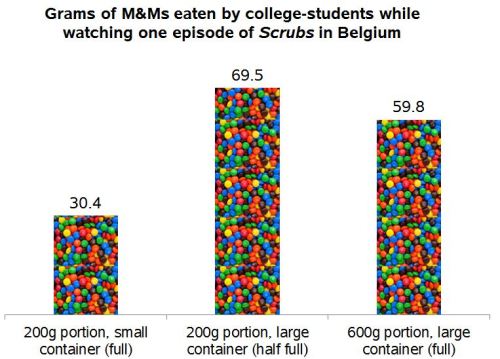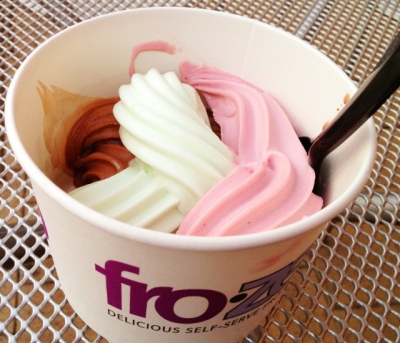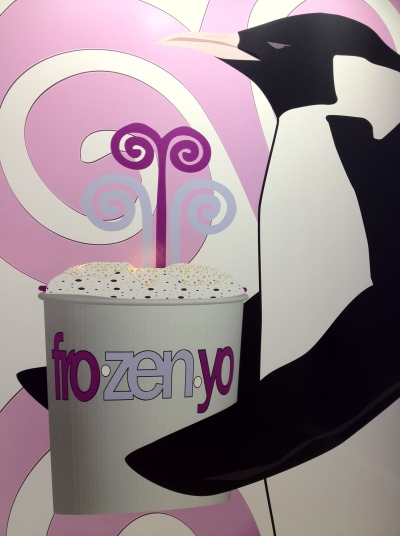Cross-posted at Family Inequality.
People don’t know how much they’re eating.
A recent experiment found that people eat more when the container is larger, even when the portion size is not. They gave Belgian college students a container of M&Ms and parked them in front of a TV, with some cover story. The students were randomly assigned to three groups, medium-portion/small-container, medium-portion/large-container, and large-portion/large-container. These were the results:  The ones who got the large container ate more, whether it was full or not (the difference between the two wasn’t significant).
The ones who got the large container ate more, whether it was full or not (the difference between the two wasn’t significant).
These kinds of experiments continuously suggest that distractions, distortions and other apparently irrelevant information and events routinely have large effects on people’s eating practices (here’s an extensive review). One infamous study showed that even people served 14-day-stale popcorn at the movies ate 34% more when it was served in a large container. In an earlier popcorn study, researchers found that people given large containers not only ate more, but were less able to report how much they ate. They concluded:
When a food is eaten from a large container, it appears easy to lose track of how much one eats. Even if the food were to taste relatively unfavorable, eating it from a large container may cause one to overeat because they lose track of how much they have consumed.
About that Yogurt Tub…
All this occurred to me when I visited one of our many local Frozenyo franchise outlets. It’s a self-serve frozen yogurt place where you pay one price by weight no matter what you put in your bucket. The trick that impressed me is the bucket — there is only one size, and it’s very large. But you can’t judge how big it is because there’s nothing to compare it with — no sizes or prices on the wall, no mini cup for kids — just one stack of identical buckets. So the person who posted this picture on Yelp probably thought she had a reasonable size serving, since the thing is barely half full:
There are three possible ways to judge your self-served serving size. You can go by the tub (“I filled it half way”), you can go by the person next to you (“sheesh!”), or you can look at the cartoon penguins on the wall:
How much is the penguin eating? I took home one of the buckets, and measured the volume of water it holds: 18 ounces. In comparison, a standard kid-sized serving bowl, the kind some people use to give their kids ice cream at home, holds 12 ounces:
An innocent child used to half a bowl of ice cream — in the bowl on the left — might be pretty steamed if you served her this:
According to the serving size information on the back wall of Frozenyo, I think that’s about 1.5 servings, or 150 calories of the nonfat variety, before toppings. The penguin’s overflowing bowl is 5.0 servings. With no toppings that’s 500 calories. If you pile it with M&Ms, sprinkles, hot fudge, Captain Crunch, coconut topping and fresh kiwis, who knows. It’s not really that many calories to consume — the same number as a single slice of banana bread at Starbucks.
But the point is you don’t know how much you’re eating. One Yelp reviewer cautioned that you can get a stomach ache after eating at Frozenyo, because “your eyes are bigger than your stomach.” I think it’s because the dump-truck sized delivery vehicle you eat it out of is bigger than your stomach.
But most reviewers love it for the individual control over serving size and toppings, and the reasonable price ($.39 per ounce by weight, or $5-$6 for a typical load).* I think it’s a winning business model, with low labor costs, because all you need is one person to pour the mix into the machines and another to weigh the tubs and swipe credit cards. According to the company’s ambitious map, there are still 46 states with “territory available.”
If I were them, I would increase the bucket size by 5% per year. I doubt anyone would notice.
* Paging George Ritzer: it’s the irrationality of rationality.





Comments 20
Yunnan Chen — October 2, 2012
I have this problem everytime I go to Menchies (froghurt place in Vancouver). One size cups, no exceptions. I try and fill it up halfway and not get carried away with the toppings, but most of the customers are children - the whole happy colourful decor of the place is targetted at children with its happy faces and free stickets - and a lot of these kids probably have the same serving sizes as I do. The lack of child-sized servings is really irresponsible marketing, in my opinion, and it probably makes the supervising adult's job much harder.
Leslee Bottomley Beldotti — October 2, 2012
The very first time I visited a frozen yogurt store, my friend astutely pointed out the problem with the over-sized bucket containers. The fact that I have to work extra hard to determine an appropriate portion of yogurt makes me resentful towards the yogurt stores, so I rarely patronize them.
Umlud — October 2, 2012
The only two times that I've gone to my local variety of fro*zen*yo, I went with my girlfriend, and we shared the single bucket. And it was more than enough for me.
The Buzz — October 2, 2012
18 ounces is almost a large drink at Starbucks/Dunkin Donuts/etc.! I can't imagine filling one of those with frozen yogurt (that much latte is usually too much even for a caffeine and sugar fiend like me), and I doubt many people would. The shape of the cup probably influences on how much people are willing to put into it as well. Which I'd say is brilliant on the part of the company but pretty disturbing for the rest of us.
Koggish — October 2, 2012
I worked at a frozen yogurt shop in high school, and our small cone was a 4 oz serving. Medium was 6 oz, large 8 oz. The large cone was more than enough to make a person full, and to think it wouldn't even fill half! of that bucket. Sheesh.
Tusconian — October 2, 2012
This is a phenomenon I really hate. There's really no reason to have even an 18 ounce option for frozen yogurt for one person, much less have that be the only option. But most American restaurants and food chains are subscribing to the "bigger is better" idea of food, which honestly just leads to excess and waste. People feel cheated if they don't get twice as much food as they can reasonably eat, and many people take that "twice as much" as a personal challenge; sure, they may have been served a 3 pound sandwich with a side of 2 pounds of fries and limitless refills of a 24 ounce (or larger) soda, but god dammit, they will eat it ALL! And if not, the rest is going in the garbage. It just leads to so much edible food going to waste (and I don't blame individuals who can't or don't eat it all; in most cases, that is the healthy choice and forcing themselves to eat it all would just make them puke), and people having no concept of what "a serving" or "a healthy meal" look like.
A though I had as well: even if someone could visually determine how much they wanted and didn't mind the 6 ounces of ice cream looking like that picture, it would be sort of hard to eat.
Lucharepacifico — October 4, 2012
How long have potato chip (or any other bagged product) companies known about this?!
Friday Links — October 5, 2012
[...] Froyo will kill you Share this:ShareEmailFacebook [...]
Fat news lady promotes obesity and gets tremendous backing - Page 3 - PeachParts Mercedes ShopForum — October 8, 2012
[...] here's an interesting study on portion size and how it affects consumption. The graph is made from m&ms! Out of curiosity, [...]
Anthony Tantillo — October 9, 2012
Why is a socological blog caring about proportion? Is fat shaming okay now?
hi — December 15, 2013
it looks like poo
Sociopress.cz » Jak velký je ten kelímek? — August 10, 2014
[…] http://thesocietypages.org/socimages/2012/10/02/yo-how-big-is-that-yogurt-bucket-2/ […]
Matt — June 9, 2016
Never heard of the place, but I don't even like yogurt. I think I would just fill the cup with blackberries, strawberries, Almonds, Toffee and dump a bunch of caramel on it.